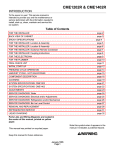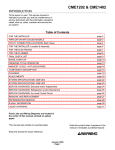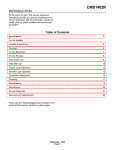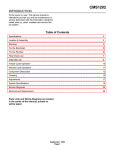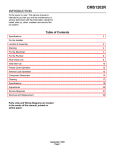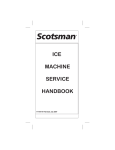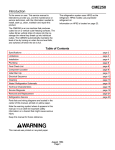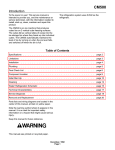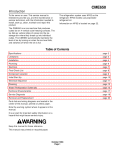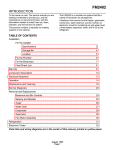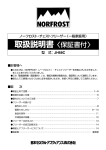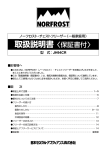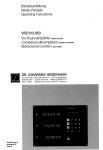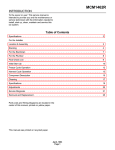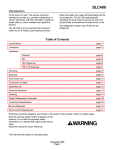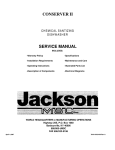Download Scotsman CMS1402 Service manual
Transcript
CMS1402 INTRODUCTION To the owner or user: This service manual is intended to provide you and the maintenance or service technician with the information needed to install, start up, clean, maintain and service this ice system. Table of Contents Specifications . . . . . . . . . . . . . . . . . . . . . . . . . . . . . . . . . . . 2 For the Installer Location & Assembly Stacking . . . . . . . . . . . . . . . . . . . . . . . . . . . . . . . . 3 . . . . . . . . . . . . . . . . . . . . . . . . . . . . . . . . . . . . . 4 For the Electrician . . . . . . . . . . . . . . . . . . . . . . . . . . . . . . . . . 5 For the Plumber . . . . . . . . . . . . . . . . . . . . . . . . . . . . . . . . . . 6 Final Check List . . . . . . . . . . . . . . . . . . . . . . . . . . . . . . . . . . 7 Initial Start Up . . . . . . . . . . . . . . . . . . . . . . . . . . . . . . . . . . . 8 Freeze Cycle Operation . . . . . . . . . . . . . . . . . . . . . . . . . . . . . . . 10 Harvest Cycle Operation . . . . . . . . . . . . . . . . . . . . . . . . . . . . . . . 11 Component Description . . . . . . . . . . . . . . . . . . . . . . . . . . . . . . . 12 Cleaning . . . . . . . . . . . . . . . . . . . . . . . . . . . . . . . . . . . . . 15 Adjustments . . . . . . . . . . . . . . . . . . . . . . . . . . . . . . . . . . . . 17 System Specifications . . . . . . . . . . . . . . . . . . . . . . . . . . . . . . . . 19 Service Diagnosis . . . . . . . . . . . . . . . . . . . . . . . . . . . . . . . . . 20 Removal and Replacement . . . . . . . . . . . . . . . . . . . . . . . . . . . . . . 23 Parts Lists and Wiring Diagrams are located in the center of this manual, printed on yellow paper. September 1993 Page 1 CMS1402 FOR THE INSTALLER The CMS1402B will fit the following Scotsman ice storage bin (48" wide): BH900, and with adaptors, onto the following Scotsman ice storage bins: • BH1000 (with KBT21) or BH1360; and it will stack (with kits) onto the following ice machines: • CMS1202, or CMS1402 (use KSCMS48). The stacking kit includes gaskets and trim strip. The normal finish for the machine is enamel sandalwood. An optional stainless steel panel kit (SPKCMS48) can be field installed. It contains a stainless steel top, left side panel, an overlay right side panel, and front panels. Scotsman Ice Systems are designed and manufactured with the highest regard for safety and performance. They meet or exceed the standards of U.L., N.S.F., and C.S.A. Scotsman assumes no liability or responsibility of any kind for products manufactured by Scotsman that have been altered in any way, including the use of any parts and/or other components not specifically approved by Scotsman. Scotsman reserves the right to make design changes and/or improvements at any time. Specifications and designs are subject to change without notice. Note: "B" model’s have two front panels, production began early 1992. Water Cooled Air Cooled Model Number Dimensions (w/o bin) W" x D" x H" Basic Electrical Minimum Circuit Maximum Ampacity* Fuse Size Refrigerant Condenser Charge Type CMS1402AE-3B 48 x 243⁄8 x 271⁄2 208-230/60/3 20.2 20 60 oz. R-22 Air CMS1402WE-3B 48 x 243⁄8 x 271⁄2 208-230/60/3 19.5 20 64 oz. R-22 Water CMS1402AE-32B 48 x 243⁄8 x 271⁄2 208-230/60/1 31 30 60 oz. R-22 Air CMS1402WE-32B 48 x 243⁄8 x 271⁄2 208-230/60/1 30.3 30 64 oz. R-22 Water * Minimum Circuit Ampacity is used to determine wire size and type per the National Electric Code. If the numbers listed above are not the same as the nameplate, go by the nameplate. This ice system is designed to be installed indoors, in a controlled environment. MINIMUM MAXIMUM Air Temperature 0 50 F. 1000F. Water Temperature 400F. 1000F. Water Pressure 20 psi 80 psi September 1993 Page 2 CMS1402 FOR THE INSTALLER: Location & Assembly Location: After uncrating and inspection, the unit is ready for installation. It is important that the machine be installed in a location where it has enough space around it to be accessible for service. A minimum of 6" must be allowed at the back for air circulation on air cooled models. Try to avoid hot, dirty and crowded locations. Be sure that the location for the machine is within the envrionmental limitations. Storage Bin: ICE MACHINE AND BIN ASSEMBLY Tip the storage bin on its back, using parts of the carton to protect the exterior finish. Install the casters, use a heavy duty leg kit if stacking two ice machines on one bin. 1. Arrange for proper electric, water and drain. See instructions for the plumber and for the electrician. 2. Single ice machine on bin: Use legs packed with the bin. After mounting the legs position the ice storage bin in the selected location: Two ice machines on a bin require stacking kit KSCMS48. Use heavy duty leg kt KLP6 when stacking onto the BH900. SHIPPING BRACKETS Note: Allow enough space to the left and back to service the machine. Do NOT push the bin into postion, instead, lift it there. Pushing a bin may damage the legs and leg mounts. Level the bin in both the front to rear and side to side directions by adjusting the leg levelers. Stacked units use non-adjustable legs, and must be leveled with shims. Select a well ventilated location for air cooled models. Note: Air cooled models blow air from front to back. 3. Inspect the bin top mounting gasket which should be flat, with no wrinkles, to provide a good water seal when the cuber is installed on top of the bin. Ice Maker: Install the modular cuber on top of the bin using care to be sure a good seal is made between the two cabinets. Use of a mechancial lift is recommended. Align the holes in the bottom rear of the cabinet to mate with the two mounting holes on the top rear of the bin. Use bolts and straps found on the back of the icemaker to secure the ice machine to the bin. When alignment and leveling are completed, tighten the bolts to secure the mounting straps. Remove the front panels, and remove the evaporator shipping brackets and hardware. September 1993 Page 3 CMS1402 FOR THE INSTALLER: Location & Assembly (The top removed from the lower icemaker will no longer have any function.) Stacking Instructions A stacking kit, KSCMS48, is required to interconnect the ice level controls, seal the freezing compartments, and to retain the top edges of the bottom unit’s front panels. A stainless steel bracket (from the kit) must be attached to the top of the bottom machine before the units are stacked. Follow the installation instructions of the stacking kit, but in general: Use heavy duty legs (kit KLP6). When stacking two units, remove the top panel and the evaporator cover from the lower icemaker. Place strips of gasket material (from the stacking kit) on the top edges of the bottom unit’s freezing compartment. Carefully lift the uncrated top unit onto the bottom one and align the two cabinets. Use of a mechanical lift is recommended for this step. At the back of the two icemakers, bolt the upper icemaker cabinet to the lower icemaker cabinet using the mounting straps and bolts from the hardware package. STACKING Add the relay box to interconnect the two ice machine’s bin control circuits. STAINLESS STEEL PANEL RETAINING BRACKET EVAPORATOR COVER September 1993 Page 4 CMS1402 FOR THE ELECTRICIAN SEE NAMEPLATE for current requirements to determine wire size to be used for electrical hookup. The cuber requires a solid chassis to chassis earth ground wire. See Wiring Diagram. Be certain the cuber is connected to its own electrical circuit and individually fused. Voltage variation should not exceed ten percent of the nameplate rating, even under starting conditions. Low voltages can cause erratic operation and may be responsible for serious damage to the icemaker. Electrical connections are made at the rear of the icemaker, inside the junction box. All external wiring should conform to the national, state and local electrical code requirements. Usually an electrical permit and services of a licensed electrician will be required. GROUND SCREW DETAIL OF JUNCTION BOX HAND DISCONNECT SWITCH JUNCTION BOX ELECTRICAL CONNECTIONS, WATER COOLED September 1993 Page 5 ELECTRICAL CONNECTIONS, AIR COOLED CMS1402 FOR THE PLUMBER FOLLOW ALL LOCAL CODES: CONNECTIONS: The recommended water supply line is a 3/8-inch O.D. copper tubing with a minimum operating pressure of 20 PSIG and a maximum of 80 PSIG. All drains are gravity type and must have a minimum of 1/4-inch fall per foot on horizontal runs. The drains to be installed to conform with the local plumbing code. Install a vertical open vent on drain line high point to insure good draining. The ideal drain receptacle is a trapped and vented floor drain. Recommended bin drain is 5/8 inch O.D. copper tubing and should be vented and run separately. Insulation for high humidity areas is recommended. Connect to cold water supply line with standard plumbing fittings, with shut off valve installed in an accessible place between thewater supply and the cuber. ln some cases a plumber will be required. Water Limitations: An ice machine is a food manufacturing plant, it takes in a raw material, water, and turns it inot a food product, ice. The purity of the water is very important in obtaining pure ice and in maximizing product life. It is generally better to filter the water, although there is no one filter that will cure all water problems. A good filter combined with a polyphosphate feeder gives about the best overall performance. Cold, potable water must be supplied to the water inlet fitting. Water Cooled models require another inlet connection to the condenser, and another drain for the condenser. The drain must be separate from the bin drain. Bin Drain: The bin drains from the bottom, and needs no vent unless there is a long horizontal run. Terminate drains above the drain receptacle with the proper air gap per local code. The ice machine sump drain is 3/4" FPT. There must be a vent at this connection for proper sump drainage. AIR COOLED CONNECTIONS OPTIONAL SUMP DRAIN MUST FILTER 3/8" MALE BE VENTED FLARE POTABLE WATER SUPPLY WATER COOLED CONNECTIONS CONDENSER INLET HAND SHUT OFF VALVE 3/4" FPT AIR GAP BETWEEN DRAIN LINES AND BUILDING DRAIN AIR GAP BETWEEN DRAIN LINES AND BUILDING DRAIN VENT WATER SUPPLY AND DRAIN CONNECTION September 1993 Page 6 BIN DRAIN CONDENSER DRAIN CMS1402 FINAL CHECK LIST 8. Is the water supply line shut off valve installed and electrical wiring properly connected? 1. Is the cabinet in a room where ambient temperatures are within the minimum and maximum temperatures specified? 2. Is there at least six inches clearance at the left and back sides of the cabinet for proper air circulation? (Air Cooled models) 3. Has water supply pressure been checked to insure a minimum of 20 PSIG and a maximum of 80 PSIG operating pressure? 4. Is the cabinet level? 5. Check that any shipping material has been removed from inside the cabinet. 6. Check that the reservoir is properly secured to the bottom of the evaporator plates. 7. Have all electrical, water and drain connections been made? 9. Check all refrigerant lines and conduit lines, to guard against vibration or rubbing and possible failure. 10. Have the bin and cabinet been wiped clean? 11. Has the Manufacturers Registration form been properly filled out? Check for correct model and serial numbers from Serial nameplate, then mail the completed card to the SCOTSMAN factory. 12. Has the owner/user been given the Service Manual and instructed how to operate and maintain the icemaker? 13. Has the owner been given the name and telephone number of the authorized SCOTSMAN Service Agency serving him? LEVEL ASSEMBLY SUMP DRAIN HAND SHUT OFF VALVE WATER COOLED DRAIN BIN DRAIN HAND SHUT OFF VALVE OPTIONAL FILTER FINAL INSTALLATION September 1993 Page 7 CMS1402 INITIAL START UP 1. Remove the front panels by removing screws at the base and pulling out. 2. Remove two screws and the control box cover. 3. Check that the two switches on the control box, the ICE-OFF-WASH rocker switch and the COMPRESSOR ON-OFF toggle switch are in the OFF position. FRONT VIEW OF TIMER ACTUATOR BUTTON MICROSWITCH 4. OPEN the water supply line shut off valve. 5. Switch the electrical power to the machine ON. CAM 6. Inside the control box is the shaft of the timer and the switch assembly. Rotate the shaft of the timer until the actuator arm on the microswitch drops off outer cam into cam slot. See “Front View of Timer”. 7. Move the ICE-OFF-WASH rocker switch to the ICE position. 8. Check the water fill cycle: For several minutes the inlet water valve will be open and water will flow into the reservoir. Near end of the fill cycle, water should be overflowing the reservoir and draining thru the reservoir drain. If at the end of the fill cycle the reservoir is not full, repeat step 6. HARVEST PORTION FREEZE PORTION Check that the sump covers are snapped in place. Check that the water distributors are properly seated at the top of the evaporators, and that water is flowing over all of the cube cells. CONTROL BOX Note: Some water may spray from the evaporators is normal when the machine is new. The spray will stop after a few batches of ice. 9. When the sump has filled, move the compressor ON-OFF toggle switch, to the ON position. 10. On air cooled models the fan motors will begin to blow warm air out the back of the machine. Water cooled models will begin to flow warm water out of the condenser drain. CUBE SIZE CONTROL Note: To optimize the balance between ice production and water use, the freeze cycle discharge pressure must be 220 P.S.I.G. Check the discharge pressure and adjust the water regulating valve to obtain 220 P.S.I.G. discharge. 11. Check operation of the freezing cycle: Ice will begin to form from the top of the evaporators to the bottom. After the first cycle freezing time will range between 12 and 15 minutes. Longer time for temperatures above 70oF. and shorter time required when temperatures are below 70oF. Average complete cycle time is about 16 minutes. September 1993 Page 8 TIMER ON/OFF/WASH SWITCH ICE LEVEL CONTROL CMS1402 INITIAL START UP CUBE SIZE DIAGRAM 12. After an ice harvest check Cube Size. There is just enough water available in the reservoir to make one full sized batch of cubes. The water pump may pick up some air at the end of the freezing cycle, so at the end of freeze some bubbles in the pump discharge hose is normal. If the water pump stops pumping water before the end of freeze, the cube size control may be set too cold, or the water system may be leaking water. Compare cube size to the "Cube Size Diagram" To adjust cube size, locate cube size control on the front of the control box. Rotate the adjustment screw one eighth of a turn: • Clockwise for larger ice cubes • COUNTER Clockwise for smaller ice cubes Observe size of the ice in the next ice cube harvest and repeat the adjustment until the correct ice cube size is achieved. JUST RIGHT When the cubes are the correct size, they will be connected together vertically, and drop off in strips. The batch weight will be about 13.5 to 14.5 lb. Note: If the cubes at the bottom rows of some evaporators are smaller than others, the size difference does not affect capacity or performance. However, there should be some ice in all cells. If not, contact the Factory. TOO SMALL 13. Check harvest time. There must be enough time in the harvest cycle to defrost all the cubes, but not an excessive amount that will waste capacity. The length of the harvest cycle is determined by the timer cam positions. CAMS If needed, adjust the harvest time so there are about 15 seconds of harvest time left after the last cube has fallen from the evaporators. Because harvest time varies with the water and air temperatures at the ice machine, colder air and water will result in faster ice making, but require more time for harvest. Do NOT adjust harvest time too short or the machine will not harvest all the ice. The harvest time is set by: loosening the set screw on the timer cam, rotating the shaft until the opening between the cams is either increased or decreased, and retightening the set screw. More of an opening between the high parts of the two cams = more harvest time. SET SCREW ADJUSTMENT OF THE TIMER The bin level control has two postions: Full and Partial. Full is about 8" from the bottom of the transducer socket. Note: The unit will make one batch of ice when full if switched Off and then On. An adjustment of the cube size control may be needed after the harvest time has been changed. Check cube size again. 15. Wash out the bin with clean, potable water. 14. Check Bin Ice Level Control: With the icemaker in the harvest cycle, place something solid directly below the transducer socket (located in the base to the left of the evaporators). The machine will then switch off at the END OF THE HARVEST CYCLE. Within seconds after removal of the obstruction, the icemaker will restart. 17. Fill out the Warranty Registration and Customer Evaluation form and send it in. Explain to the owner/user the significant specifications, operation, and maintenance requirements of the ice machine. Inform the owner of the name and telephone number of the local authorized SCOTSMAN Distributor, or service agency. 16. Replace all covers, panels and screws. September 1993 Page 9 CMS1402 FREEZING CYCLE OPERATION Water from the sump assembly is pumped to the water distributor system at the top of each evaporator plate. From the water distributor the water cascades by gravity over all cells of the plate and to the sump assembly below. At the beginning of the freezing cycle, the electrical circuit is completed to the compressor and the water pump. The water pump operates continuously, through both the freezing cycle and the harvest cycle. During the freezing cycle, the hot gas solenoid valve and the water inlet solenoid valve are CLOSED. When the ice cubes are partially formed, the cube size control (sensing bulb attached to the suction line) will CLOSE, and connect power to the timer motor. The timer then controls the remainder of the freezing cycle. The timer will keep the icemaker operating in the freezing cycle for a selected length of time. This will give the ice cubes time to fully form. after which, the timer will switch the icemaker into the harvest cycle, through the contacts of the timer assembly microswitch. WATER DISTRIBUTION INLET WATER VALVE DRAIN RESERVOIR WATER SCHEMATIC HOT GAS VALVE CONDENSER FAN MOTOR WATER MANIFOLD EVAPORATOR WATER INLET VALVE DISCHARGE COMPRESSOR LINE ACCUMULATOR WATER PUMP REFRIGERATION SCHEMATIC September 1993 Page 10 RESERVOIR CMS1402 HARVEST CYCLE - HOT GAS BYPASS When the timer switches the icemaker into the harvest cycle, the finish relay is de-energized, and the hot gas valve and inlet water valve OPEN. Then high pressure, high temperature gas refrigerant being discharged from the compressor is diverted from the condenser through the hot gas solenoid valve into each evaporator plate. During this cycle, the refrigerant bypasses the condenser. Both the compressor and the water pump are operating. The finished ice cubes are released from the sides of each evaporator plate by the warming effect of the hot gas condensing in each evaporator plate and the water cascading over the ice cubes. The released ice cubes drop into the ice storage bin below. At the end of the harvest cycle, the timer cam will push in the microswitch actuator arm. If there is no ice close to the bin level control’s transducer, a whole new cycle will begin. If there is ice within 8" of the base of the machine (when the bin level control is set for full) the icemaker will shut OFF. FAN MOTOR WATER DISTRIBUTION INLET WATER VALVE DRAIN RESERVOIR WATER SCHEMATIC HOT GAS VALVE WATER MANIFOLD CONDENSER EVAPORATOR WATER INLET VALVE WATER PUMP DISCHARGE LINE COMPRESSOR ACCUMULATOR REFRIGERATION SCHEMATIC September 1993 Page 11 RESERVOIR CMS1402 COMPONENT DESCRIPTION Cube Size Control Timer - Timer & Switch Assembly This reverse acting thermostat controls the length of the freezing cycle. It is sensing the temperature of the suction line. When the suction line gets cold enough, the cube size control closes (on temperature fall) and starts the timer. A change in either ambient air or incoming water temperature will affect the efficiency of the refrigeration system, and this will vary the length of time it takes the evaporator to reach the temperature at which the cube size control is preset to close. See CUBE SIZE ADJUSTMENT BEFORE attempting to adJust the control. The timer cam is controlled by the cube size control. The outer surface, or large diameter lobe of the timer cam, determines the timer cycle for finish freezing of the ice cubes, while the inner surface, or small diameter lobe, determines the time cycle for the harvest cycle. Relay The multi-function, three pole, double throw, plug-in relay is inserted into a receptacle on the printed circuit board in the control box. The relay functions in part to by-pass the bin thermostat control to prevent the icemaker from shutting OFF, when the bin thermostat opens during the freezing cycle. The bypass action ensures full-sized ice cubes with each harvest cycle and prevents short cycling on the bin thermostat control. When the microswitch button is pushed in there is power connected to the coil of the relay, and the unit is in the freeze cycle. When the microswitch button is released, the power to the relay is stopped, and the unit goes into harvest. The microswitch is actuated by a cam assembly directly connected to the timer motor. One complete rotation of the cam will take eight minutes. Harvest is preset at three and one half minutes, but is adjustable. High Pressure Safety Control This is a manual reset control that shuts down the icemaker, should the discharge pressure ever reach 450 PSIG (air cooled) or 350 PSIG (water cooled). Found below the control box. CONTROL BOX CUBE SIZE CONTROL RELAY TIMER AND MICROSWITCH ICE/OFF/WASH SWITCH BIN ICE LEVEL SELECTOR SWITCH September 1993 Page 12 CMS1402 COMPONENT DESCRIPTION Bin Level Control This electronic control uses sound waves to measure the distance between the bottom of the ice machine and the top of the ice in the bin. It is designed to control the machine’s ice production to maintain that distance. Because it uses sound waves, a slight “ticking” sound can be heard coming from the bottom of the machine. There are two parts to the control, the circuit board, and the level control switch. The control is adjustable so that the ice machine will maintain a certain height of ice. When set at FULL it will not allow the machine to fill the bin any closer to the ice machine than about 8", and it will not work if the distance to the bottom of the bin is greater than 8 feet. BIN ICE LEVEL SELECTOR SWITCH ICE/OFF/WASH SWITCH SOUND WAVES THE USER CAN SELECT THE AMOUNT OF ICE TO BE MAINTAINED IN THE BIN. FULL PARTIAL September 1993 Page 13 CMS1402 COMPONENT DESCRIPTION Water Inlet Solenoid Valve The water inlet solenoid valve fills the sump assembly with water. Extra water overflows out the overflow standpipe of the sump. This action fills and rinses the sump during each harvest cycle. The flow rate is 1 g.p.m. Water Distribution System The water distribution system functions to evenly supply water to all cells of the evaporator plates. The water pump pumps water from the sump up the vertical tygon tube to the tee. From there water is channeled through the water manifold to the water distributors, above each evaporator plate, and from six holes within each distributor, water flows to the cells of each side of the evaporator plates. Gravity flow returns the unfrozen excess portion of water to the sump reservoir for recirculation. Hot Gas Solenoid Valve The hot gas solenoid valve opens only during the harvest cycle, to divert the hot discharge gas from the compressor, by passing the condenser and capillary tube, for direct flow to the evaporator plates to release ice cubes from the ice cube molds. WATER DISTRIBUTORS SUMP STANDPIPE Fan Pressure Control - Air-Cooled Models only. ln both freeze and harvest cycles, the fan pressure control functions to maintain a minimum discharge pressure by cycling the fan on and off. The approximate C.I. is 210 PSIG and C.O. is 193 PSIG.OPTIONAL WATER FILTER Strainer A water strainer is located in the potable inlet water HAND line before the water inlet solenoid valve. Clean VALVE the water strainer frequently. SUMP PUMP COMPONENT LOCATION September 1993 Page 14 DRAIN CAP CMS1402 CLEANING ///////////////////////////////////////////////////////////////////////////////////////////////////////////////////////////////////////////////////////////// A Scotsman Ice System represents a sizable investment of time and money in any company’s business. In order to receive the best return for that investment, it MUST receive periodic maintenance. Maintenance and Cleaning should be scheduled at a minimum of twice per year. ///////////////////////////////////////////////////////////////////////////////////////////////////////////////////////////////////////////////////////////// CLEANING: ICEMAKER 7. Pour the cleaning solution into the reservoir until full. 1. Remove screws and the front panel. 2. Switch the compressor switch to OFF. Switch 8. Move the WASH/OFF/ICE switch to the WASH position. 9. Let the unit operate for 30 minutes. Electrical Shock Hazard. Electrical shock can cause personal injury. Cleaning procedures are done with the power ON. the WASH/OFF/ICE switch to OFF. 3. Remove the control box cover, and rotate the shaft of the timer and switch assembly CLOCKWISE advancing to the freezing cycle. (Beginning of the higher part of the cam against the microswitch). 4. Open the ice storage bin door and empty the bin of ice. 5. Remove the hose clamp, rubber cap and drain all the water from the sump assembly into a container. Replace the rubber cap and hose clamp. 6. Mix 24 ounces of Scotsman Ice Machine Cleaner with 2 gallons of warm (950F. - 1150F.) water. Scotsman Ice Machine Cleaner contains acids. These compounds may cause burns. If swallowed, DO NOT induce vomiting. Give large amounts of water or milk. Call Physician immediately. In case of external contact, flush with water. KEEP OUT OF THE REACH OF CHILDREN. During the wash cycle, if the machine runs out of solution, mix 2 more gallons of solution per step 6, refill the sump and continue the wash cycle for the remainder of the 30 minutes. 10. Move the WASH/OFF/ICE switch to the OFF position. 11. Remove the reservoir drain cap and drain the cleaning solution from the sump. Replace the drain cap. 12. Rotate the shaft of the timer and switch assembly CLOCKWISE to the harvest position (low part of the cam against microswitch). Move the WASH/OFF/ICE switch to the ICE position to start the Harvest cycle. If, after completing this procedure, one or more evaporator plates does not have a full flow of water for each vertical column of cubes, shut down the operation and remove and clean all water distributor manifolds. Reinstall the water distributor manifolds. Note: Thie ice making portion of the water system should be sanitized after cleaning by repeating steps 2-12, except substitute an approved sanitizing solution for the cleaning solution. 13. Move the compressor ON-OFF switch to the ON position to start the icemaking process. ////////////////////////////////CAUTION////////////////////////////////// DO NOT use ice produced from the cleaning solution. Be sure none remains in the bin. /////////////////////////////////////////////////////////////////////////////////// 14. Check the next ice cube harvest to be sure that the ice cubes are clear and the acid taste is gone. 15. Add hot water to the bin to melt the ice. 16. Replace all panels. September 1993 Page 15 CMS1402 CLEANING AIR COOLED CONDENSER CLEANING 1. Disconnect electrical power. CONDENSER The fan blade can cause personal injury. Disconnect power before begining to clean condenser. AIR COOLED CONDENSER MUST BE CLEAN FILTER 2. Remove front panel. 3. Clean or replace the air filter. 4. Check to see that the inside of the condenser is clean; light should be visible through the fins. If not clean the internal parts by vacuum, pressure washer and/or coil cleaner. ICE STORAGE BIN The interior liner of the bin is in contact with a food product: ice. The storage bin must be cleaned regularly to maintain a sanitary environment. Once a week cleaning with soap and water, a hot water rinse and an air dry is a basic procedure. Scale that may form on the plastic liner can be removed by scrubbing the surface with a mixture of Scotsman Ice Machine Cleaner and hot water. Remove any scale prior to sanitizing. To Remove Scale: 1. Mix a cleaning solution of 4 ounces of Scotsman Ice Machine Cleaner to 4 pints of hot (950F. to 1100F.) water. 2. Using rubber gloves, dip a nylon scouring pad into the cleaning solution, and scrub the scale off of the liner. Scotsman Ice Machine Cleaner contains acids. These compounds may cause burns. If swallowed, DO NOT induce vomiting. Give large amounts of water or milk. Call Physician immediately. In case of external contact, flush with water. KEEP OUT OF THE REACH OF CHILDREN. 3. After all the scale has been removed, rinse all of the surfaces inside the bin with clean, potable water. To sanitize the bin and ice machine interior. Use an approved sanitizer and follow the directions and warnings of that sanitizer or use the following instructions for use of household bleach, if it meets local codes: 1. Mix a sanitizing solution of 1 ounce of household bleach to 2 gallons of water. 2. Using clean rubber gloves and a clean cloth, wipe all interior surfaces of the ice machine and ice storage bin with the santizing solution. Immerse any small parts in the sanitizing solution and wash the parts, flushing the solution thoroughly in, over and through all parts and surfaces of the parts being cleaned. 3. Allow to air dry. September 1993 Page 16 CMS1402 ADJUSTMENTS Adjustment Of The Cube Size Control //////////////////////////////CAUTION//////////////////////////////////// BEFORE adjusting the cube size control, check other possible causes for cube size problems, refer to Service Diagnosis section. DO NOT perform adjustment when a new cube size control is installed until the control bulb has been properly installed in the tube well, and the icemaker has been through a complete freezing and harvest cycle. /////////////////////////////////////////////////////////////////////////////// 2. Rotate the adjusting knob one-eighth of a turn COUNTER Clockwise. 3. Observe size of ice cubes in next ice cube harvest and, if needed, adjust again until correct ice cube size is achieved. Adjustment of the cube size control is available to change the cubes to the correct size, see INITIAL START UP. To produce LARGER sized ice cubes: 1. Locate the cube size control, on the front of the control box. 2. Rotate the adjusting knob one-eighth of a turn Clockwise. 3. Observe size of ice cubes nextWATER ice cube ADJUSTMENT OFinTHE harvest and, if needed, repeat step 2 above until REGULATING VALVE correct ice cube size is achieved. To produce SMALLER sized ice cubes: 1. Locate the cube size control, on the front of the control box. September 1993 Page 17 CMS1402 ADJUSTMENTS Adjustment Of The Timer & Switch Assembly Electrcial power present in the control box can cause personal injury. Disconnect power before begining to adjust timer. To Adjust The Timer & Switch Assembly: The length of the harvest cycle can be changed by loosening the set screw on the cam, and then rotating the shaft so that the opening between the cams change. More of an opening between the cams = more harvest time. The harvest time may be reduced if not needed. This will yield more ice per day. TIMER One complete revolution of the cam on the timer takes eight minutes. The normal setting is three and a half minutes, as set at the factory. lt is important that the length of the harvest cycle allow enough time for all the ice cubes to fall from the evaporator. Too short of a time will cause the evaporator to freeze up and stop ejecting ice into the bin. Too much time wastes icemaking capacity, energy and water. Adjustment of the harvest cycle may require a corresponding adjustment of the cube size control. Rotating the shaft of the timer cam clockwise will allow putting the machine into either the freezing cycle or harvest cycle, as required in the cleaning instructions. CAM ADJUSTING TIMER MICROSWITCH CLOSE UP VIEW OF TIMER SWITCH ACTUATOR CAM September 1993 Page 18 CMS1402 SYSTEM SPECIFICATIONS The following numbers can be used as a guideline . There will be some variation from unit to unit. Typical Cycle Time • 14-16 minutes @ 70oF. air and 50oF. water; 17-18 minutes @ 90oF. air and 70oF. water. Typical Harvest Ice Weight • 13-14 lbs. Typical Low Side Pressure • 20-21 PSIG @ 70oF. air and 50oF. water • 21-22 PSIG @ 90oF. air and 70oF. water Typical Freeze Cycle Discharge Pressure • Air cooled: 280-240 PSIG @ 90oF. air/70oF. water; 210 PSIG @70oF. air/50oF. water by end of freeze. • Water Cooled = 220 PSIG Refrigerant Charge • Air Cooled = 60 ounces of R-22 • Water Cooled = 64 ounces of R-22 Harvest Time • Preset at 3.5 minutes, may be adjusted to suit local conditions Typical Suction Pressure in Harvest • 60-70 PSIG @ 70oF. air and 50oF. water • 70-80 PSIG @ 90oF. air and 70oF. water Typical Discharge Pressure in Harvest • 100-110 PSIG @ 70oF. air and 50oF. water • 120-130 PSIG @ 90oF. air and 70oF. water. Typical Compressor Amp Draw Single phase • Beginning freeze = 13-14, End of Freeze = 11-12, Harvest = 16-17 Three phase • Three phase amps vary between 8 and 12 High Pressure Cut Out • High pressure safety, (air cooled) Manual reset, cut out at 450 PSIG • High pressure safety, (water cooled), Manual reset, cut out at 350 PSIG Fan Pressure Switch • 210 PSIG cut in, 193 PSIG cut out Compressor • Copeland CRL3-0350-PFV-270 (single phase) • Copeland CRL3-0350-TF5-270 (three phase) Ice Level Control • Maximum Range = 8 feet • Partial Fill Setting:= 21" - 22" from the base of the ice machine Timer • 1 revolution takes 8 minutes Cube Size Control • Cut In adjustable between 0oF. and +250F. September 1993 Page 19 CMS1402 SERVICE DIAGNOSIS: Electrical and/or Adjustments SYMPTOM POSSIBLE CAUSE PROBABLE FIX Nothing operates Bin level control holding machine off Bin is full - use some ice. Check ice level control circuit, see page 22. Makes thick ice/freezes up No Power Reconnect power High pressure control open Reset, check machine High temperature cut out open Hot gas valve leaks thru, replace P. C. Board Open Replace board Master switch open Test/replace Timer contacts open Replace timer Harvest cycle too short Adjust timer Water inlet valve restricted Clean or replace valve Low water pressure Check water filter or supply Hot gas valve defective Replace hot gas valve Water reg. valve (water cooled) leaks Replace water reg. valve through Runs, makes no ice Low refrigerant charge Locate leak, repair, replace drier, evacuate and weigh in nameplate charge. Air intake temperature too high (air cooled) Reduce room temperature Sump covers out of position Re-position sump covers Cubes too small Adjust cube size Cube size control stuck open Replace cube size control Pump problem or water leak in reservoir Check water system and pump Water inlet valve either lets in no water or leaks through Replace inlet water valve Low refrigerant charge Locate leak, repair, replace drier, evacuate and weigh in nameplate charge. Timer stuck Replace timer Relay does not energize; unit stuck in Replace relay harvest Long freeze cycle Cubes too small Cubes too large Water inlet valve leaks through Replace inlet water valve Dirty condenser Clean condenser Air intake temp. too high Reduce room temperature Water temperature too high Advise user Cube size set wrong adjust cube size Cubes size control stuck closed Replace cube size control Water inlet valve leaks through Replace inlet water valve and adjust cube size control September 1993 Page 20 CMS1402 SERVICE DIAGNOSIS: Refrigeration and/or Mechanical SYMPTOM POSSIBLE CAUSE PROBABLE FIX Poor harvest Too short harvest time Check and adjust harvest time Restriction of incoming water Check supply, filter, strainer and valve Hot gas valve does not open Check for power to the coil, check for not opening, replace Not enough refrigerant Locate leak, repair, replace drier, evacuate and weigh in nameplate charge. Cube size too small Adjust with cube size control Unit cycles off during freeze or harvest Hi temperature switch opens and closes Hot gas valve leaks thru, replace it Loose connection on PC board Check and replace P C board Low capacity High head pressure, from dirty condenser, faulty fan motor, or fan control Clean condenser, repair fan motor or control Non condensable gas in the system Purge system, evacuate and weigh in nameplate charge Poor air circulation or extreme hot location Relocate the cabinet; or provide ventilation Overcharge of refrigerant Evacuate and weigh in nameplate charge Cube size too big, unit runs out of water before harvest Adjust cube size control Inlet water valve leaks thru Replace valve Hot gas valve leaks thru At the end of the freeze cycle there should be frost on the evaporator end of the hot gas tubes, if not replace the hot gas valve Reservoir leaks Repair leak Inlet water valve restricted Clean or replace valve Short harvest cycle Adjust timer Water pressure too low Check supply Something blocking transducer Remove blockage Transducer is wet Remove transducerand shake screen dry. Control set on partial Set control to full. Ice level control failiure Check circuit, see next page. Timer stuck; does not turn Replace timer Unit runs out of water Unit shuts off before bin is full Unit does not shut off September 1993 Page 21 CMS1402 SERVICE DIAGNOSIS: Ice Level Control Circuit CONDITION DETERMINE CAUSE PROBABLE CORRECTION Ice Machine does not run, it has power to it, the high pressure control is closed, the on/off switch is set to ON. A. Listen for a ticking sound from transducer. If no noise, go to C. If there is a noise, check for a light on the board (models built after 4/93). If there is a light on, check relay contacts N.O. and COM. The contacts should be CLOSED. If closed, go to D. If not, replace the board. If light is off, or prior model, go to B. B. Remove front panel(s), twist transducer 1/4 turn and pull out. DO NOT UNPLUG with power connected. Examine the transducer, the inside must be clean and dry. If the inside of the transducer (above screen) was wet, replace it. Set bin level to FULL and aim at an object about 1-3 feet away. Machine should restart, if not go to D. C. Check power to bin level control Should be 12 volts from transformer, board. if not replace transformer. If there is power go to D. D. Disconnect electrical power and test ice machine circuit by attaching a jumper wire between bin thermostat posts on circuit board part no. 12-1912-01 (the circuit board with the timer on it). Reconnect power. If machine does not start go back to machine circuit. If machine starts, disconnect electrical power, remove jumper wire and reconnect electrical power. Then go to E. E. Transducer or ice level board assembly defective. Replace transducer. Set bin level to FULL and aim at an object about 1-3 feet away. Machine should restart. If this does not repair unit, replace the board. Machine runs, makes ice, switches on and off, but ice level cannot be controlled. Ice level switch may be defective. On Replace ice level switch boards with a light, check by moving switch & watching light. Machine runs, but will not shut off. Board relay stuck closed. Check relay. PARTIAL VIEW OF CIRCUIT BOARD 12-1912-01 PLUG - IN RELAY TIMER BIN THERMOSTAT If COM and N.O. are closed when power is off, replace board. If open, go to B above. Electrical Shock Hazard Can Cause Personal Injury. Disconnect Power Before Servicing. Bin Thermostat Posts at Line Voltage. POSTS MENTIONED IN “D” ABOVE September 1993 Page 22 CMS1402 REMOVAL AND REPLACEMENT Water Distributor Tubes And Manifold Tubes Cube Size Control To remove the water distributor tube and manifold tube: To remove the cube size control: Electrical Shock Hazard. Electrical shock can cause personal injury. 1. Remove the front panel. 2. Slide the water distributor tube to the front about 1/8-inch along the top of the evaporator plate, until the water distributor tube can be unsnapped from the flexible notch and lifted upward. Disconnect power before begining to service components DISTRIBUTOR TUBE 1. Remove front panel. 2. Remove cover from control box. 3. Trace capillary tube, from the cube size control to the refrigerant suction line. 4. Remove the coiled capillary tube bulb from the tube well on the suction line. 5. Remove electrical leads from the cube size control. NOTCH IN CONTROL BOX 3. Unsnap and disconnect water distributor tubes from the water manifold section. To replace the water distributor tubes and manifold tubes, reverse the removal procedure. BE SURE the notches in the water manifold tubes properly engage the alignment keys in the tee. BE SURE the water distributor tube is securely fastened at the notch at both sides of the evaporator plate. Check identical attachment for the left water distributor tube and notch; also, that the distributor/manifold connections at the top center of each evaporator plate is snug against the top of the plate. REMOVAL OF THE CUBE SIZE CONTROL CUBE SIZE CONTROL 6. Remove screws and pull the capillary tube through the notch in the back of the control box. Remove the cube size control. To replace the cube size control, reverse the removal procedure. September 1993 Page 23 CMS1402 REMOVAL AND REPLACEMENT Inlet Water Solenoid Valve Assembly To remove the inlet water solenoid valve assembly: Electrical Shock Hazard. Electrical shock can cause personal injury. Disconnect power before begining to service components 1. Shut OFF water supply to machine. 2. Loosen and remove outlet water line from the inlet water solenoid valve assembly. INLET WATER VALVE Water Pump 1. Remove front panel. 2. Unplug water pump electrical connection. 3. Drain water reservoir. 4. Use corbin clamp pliers to loosen and slide corbin clamps on hoses away from pump. STRAINER 5. Remove screws retaining pump to bracket. 6. Pull pump out of ice machine. 7. Reverse to reassemble. 8. Replace front panel. 8. Reconnect electrical power. 3. Remove screws and pull the water solenoid valve out to gain access. Transducer 4. Pull electrical cord from solenoid coil terminals. 1. Disconnect electrical power BEFORE removing transducer. 5. Remove inlet water fitting from the water solenoid valve. To replace the inlet water valve assembly, reverse the removal procedures. 2. Remove the front panel and locate the transducer socket. Bin Ice Level Control Circuit Board 3. Twist inner portion of transducer counter-clockwise and push up gently. 1. Disconnect Electrical Power before removing circuit board. 4. Unplug transducer and remove from the machine. 5. Reverse steps 1-4 to reassemble. 2. Remove front panel. 3. Remove control box cover. 4. Remove wires from circuit board connections. 5. Unlock circuit board fasteners by twisting 1/2 turn. 6. Pull circuit board of off fastener posts. 7. Reverse to reassemble, refer to wiring diagram as needed. September 1993 Page 24 CMS1402 REFRIGERATION SERVICE General: • Scotsman recommends that any work on the refrigeration system only be done when it is certain that the system needs repair. • Refrigerant should not be added except as a way to determine the proper operation of the product. If the system was low on refrigerant, there is a leak, and it must be found and repaired. • Although this system uses R-22, it should not be wasted to the atmosphere, but reclaimed. • This system has a critical charge, it must be recharged with the correct amount of refrigerant as listed on the nameplate of the ice machine, or performance will suffer. • Anytime the refrigeration system has been opened, the dryer should be replaced. • When brazing the tubing connections to the hot gas valve or thermostatic expansion valve, the component must be protected by heat sink material. Specifically: Recover, reclaim or recycle refrigerant. The method chosen is up to the service company. There are various mechanical devices that may be used to recycle refrigerant at the field level, however, Scotsman requires that any refrigerant placed into a Scotsman ice machine meet ARI spec 700. Reclaim programs are available thru most refrigerant wholesalers. Use conservation minded service procedures: • Refrain from checking refrigeration pressures without reason. There are many ways to determine the proper operation of a Scotsman ice machine without using refrigerant gauges. Visual inspection of the water system, observation of the ice formation, amp draw, voltage, and other techniques will lead to proper diagnosis. Scotsman also recommends that, at the time of initial start up, gauges not be used. • If gauges must be used, do not always check the high side pressure. If the condenser is clean and seems to be operating correctly, it most likely is. The low side pressure is much more important on an ice machine than is the high side. • If gauges must be used, use very short hoses. Minimal refrigerant discharged into the hoses equals minimal refrigerant discharged into the air. • If hi side pressure must be checked, use a quick connect at the end of the discharge hose to minimize the release of refrigerant, J/B Industires part number A33000 works well. • Scotsman’s schrader valve caps must be tightened to 70 inch - pounds to insure that the valves will not leak. • If using recycled refrigerant, it must meet ARI spec 700 or have been cleaned by a machine capable of attaining ARI spec 700. If the refrigeration system must be serviced, the quality of service must insure that there will not be a repeat failure, as repeat failures will cause refrigerant to be discharged into the air by the failure or when the failure is corrected: • If there has been a compressor burn out, check for acid in the oil. If acid is indicated, extra steps must be taken to clean up the system. • Never use refrigerant, such as R-11, to clean up or flush out a refrigeration system. When system clean-up is required, the use of suction line filter-dryers and liquid line filter-dryers are recommended. • Always replace the dryer when repairing a leak or replacing a refrigeration component. • Evacuate the system with a good vacuum pump to 500 microns or less. If the triple evacuation method is used, the vacuum should be broken each time with dry nitrogen, not refrigerant. Evacuation must be from both sides of the system. • Weigh in or measure in the nameplate charge. Recharge into the high side. • Check for leaks with a high quality, electronic leak detector. Halide torches will not locate the very small leaks. • Scotsman’s schrader valve caps must be tightened to 70 inch - pounds to insure that the valves will not leak. If an ice machine is to be discarded and still contains refrigerant, Scotsman recommends that the refrigerant be recovered, reclaimed, or recycled so that it is not discharged into the air. September 1993 Page 25

























